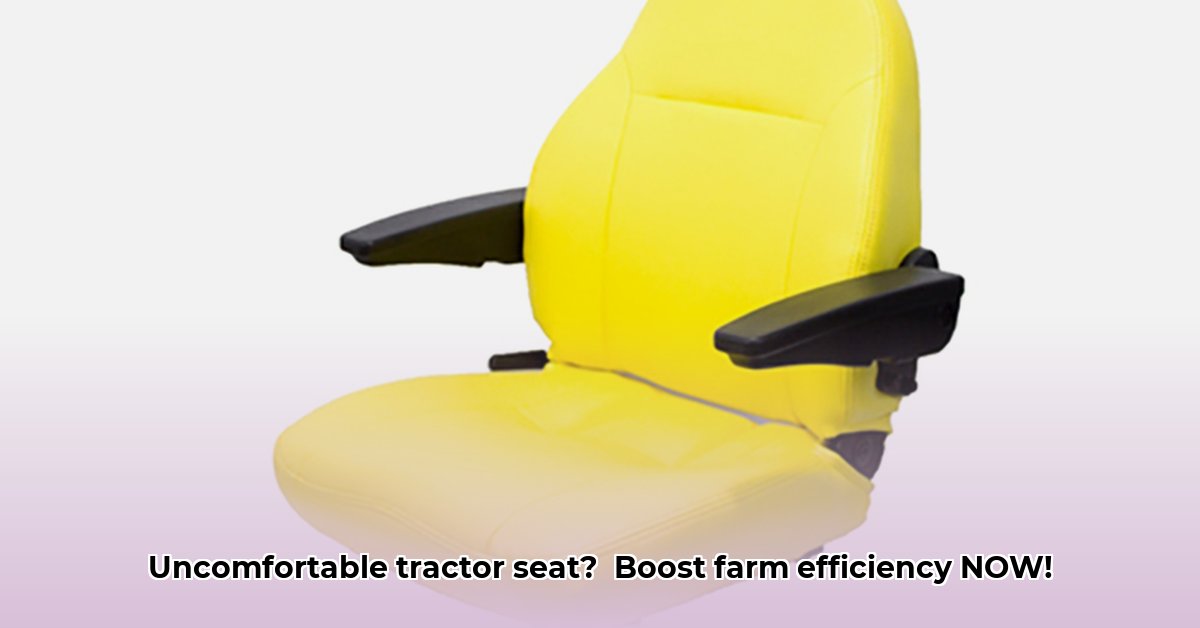
Understanding the Problem: Discomfort's Hidden Costs
Long hours on a tractor take a toll. Aching backs, stiff necks, and exhaustion aren't just uncomfortable; they directly impact productivity and profitability. Poor tractor seating contributes significantly to musculoskeletal disorders (MSDs) among farmers, leading to lost workdays and increased healthcare costs. Studies show a strong correlation between uncomfortable seats and higher MSD rates. Investing in better seating isn't just about comfort; it's a smart financial decision. A comfortable seat translates into more efficient workdays and a healthier, happier you. Don't you owe it to yourself to prioritize your well-being? For more information on advanced seating options, check out air ride seats.
Choosing the Right Seat: Finding Your Perfect Fit
Selecting the right tractor seat involves several key considerations. First, assess your tractor's compatibility. Larger tractors often accommodate larger seats with more features, while smaller tractors might have space limitations. Next, consider your body type. The seat must fit comfortably and provide proper support. Adjustability is crucial for long-term comfort, allowing you to customize the seat to your exact needs. A wide range of adjustability options will also make the seat easily suitable for multiple operators. Budgetary constraints influence choice; however, prioritizing features and long-term health is ideal. Start by identifying your needs and then selecting the best option that provides the features you need at the best price point.
Consider these key features:
- Suspension Systems: Mechanical or air suspension systems significantly reduce vibrations, a major cause of fatigue and discomfort. Air suspension seats are generally the most comfortable, but also the most expensive. Consider your needs and budget carefully.
- Lumbar Support: Essential for proper posture and back support, reducing strain and preventing injury.
- Adjustability: Height, seat angle, and lumbar support adjustments are critical for personalized comfort.
- Materials: Durable, breathable fabrics are key for long-term use. Consider the material's durability and environmental impact.
Exploring online resources like Tractorseats.com or visiting local dealers like Great Northern Equipment provides a wide variety of options.
Installation and Maintenance: Ensuring a Smooth and Safe Ride
Most tractor seat installations are relatively straightforward, often with manufacturer-provided instructions. However, if DIY isn't your strong suit, professional installation ensures correct fitting and minimizes safety risks. Regular maintenance is essential: cleaning, inspecting for wear and tear, and prompt attention to any issues all contribute to seat longevity and your safety.
Long-Term Considerations: Investing in Your Future
Regular seat inspections prevent more significant problems down the line. Materials degrade over time; timely replacement prevents unnecessary discomfort and potentially costly repairs. Also, consider sustainability. Choose durable, recyclable options whenever possible. Think about the environmental impact at every stage of the seat's lifecycle.
Case Study: A Farmer's Transformation
"After upgrading to an air suspension seat, my back pain dramatically decreased," says John Smith, a farmer from Iowa. "I can work longer hours without fatigue, and my overall productivity improved substantially." This is a clear example of how a simple investment directly improved John's health and overall productivity.
Resources
- Tractorseats.com: Wide selection of tractor seats.
- Great Northern Equipment: Local agricultural equipment dealer (example - substitute with your local dealer).
- OSHA (Occupational Safety and Health Administration): Guidelines on agricultural safety. [Link to OSHA website]
Remember, a comfortable and supportive tractor seat isn't just a luxury; it's a crucial investment in your health, your farm's productivity, and your long-term success. It's a preventative measure that benefits the farmer and the environment.